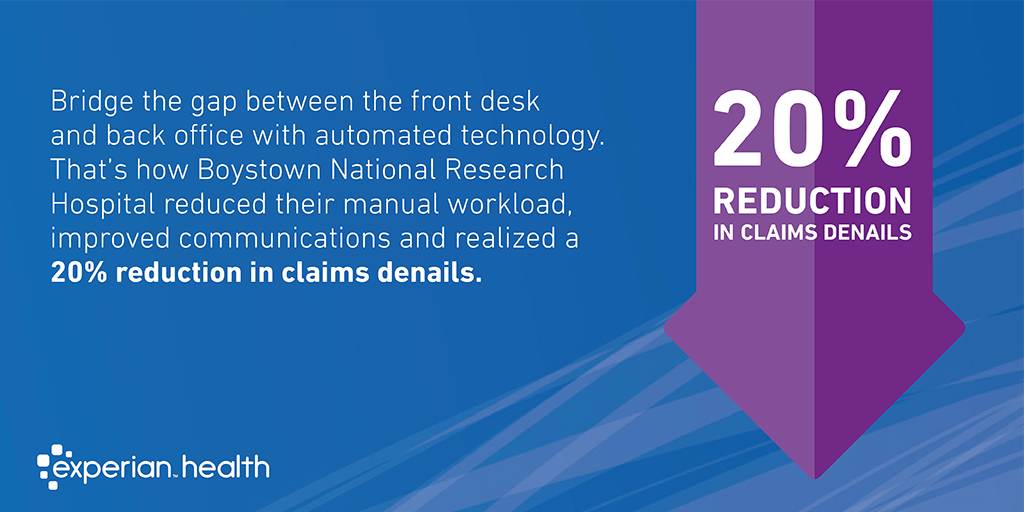
For many healthcare providers, claim denials are a frustrating cost of doing business. Each year, around 5-10% of medical billing claims are rejected (possibly more). With each claim costing around $25 to rework, providers lose billions in eroded revenue and productivity.
Any revenue leakage is bad enough, but the shift towards value-based care means tighter revenue cycle management (RCM) is even more important. In an environment where everyone must do more with less, reducing claim denials could release vital revenue and staff time to create breathing space for quality improvement.
The good news is that while only two-thirds of denials are recoverable, around 90% can be prevented. Using technology to access more reliable data, providers can eliminate avoidable denials resulting from missing or incorrect information, duplicate records, missed deadlines or unconfirmed eligibility.
As they say, prevention is better than cure.
Three ways to improve RCM and reduce claim denials
Automated technology can help optimize all stages of the revenue cycle so claims are right the first time, saving headaches down the line. Three areas to focus on are:
- Patient access – using shared systems to connect front and back office staff more effectively
- Identity management – ensuring patient and payer information is accurate from the start
- Denials workflow – enabling more efficient follow-up and analysis, to resolve denials quickly and avoid repeats.
Using technology to connect front and back office
With 30-50% of denied claims occurring earlier in the revenue cycle, streamlining patient access and registration can eliminate a significant slice of expensive errors.
Boys Town National Research Hospital  used new technology to improve communication between front and back office teams, automating up to 80%of the pre-registration workflow. More accounts could be cleared upfront, so staff could focus on claims that were more likely to cause issues. After just one year of using the automated software, all manual work was eliminated and eligibility denials dropped 20%.
used new technology to improve communication between front and back office teams, automating up to 80%of the pre-registration workflow. More accounts could be cleared upfront, so staff could focus on claims that were more likely to cause issues. After just one year of using the automated software, all manual work was eliminated and eligibility denials dropped 20%.
Clean data in, clean data out
Automating rote tasks isn’t the only way to ramp up productivity at the front end of the revenue cycle.
Around a third of all denied claims are associated with inaccurate patient identification. According to a survey from Black Book Research, this costs the average hospital $1.5 million and the U.S. healthcare system over $6 billion annually.
“As data sharing grows and challenges in connectivity are tackled, resolving patient record matching issues has become more urgent and complex,” said Doug Brown, Managing Partner of Black Book Research.
When a minor error such as a wrong insurance address can wreak such havoc, it makes sense to use demographic data to guarantee accurate patient details.
Duplication is another major issue. On average, as many as 12% of healthcare records are duplicates, mostly due to misidentification during registration. Reconciling these records costs around $1,000 per pair, amounting to millions of wasted dollars annually.
This isn’t just an administrative or financial concern. Misidentification leads to patient distrust, pharmaceutical abuses, and redundant treatment, which risk patient safety and drive up costs for patients and providers.
Healthcare staff need to feel confident that the patient is who they say they are, with a single, complete record. Using technology that can apply an algorithm of sophisticated matching methodologies can clean up patient data and eliminate duplicate and inaccurate records.
Resolve denials quickly and learn from mistakes
Finally, when denials do occur, they must be managed efficiently.
Schneck Medical Center upgraded its denial management process, giving staff real-time insight into how claims are progressing. Automated software identifies which claims need following up, so back office staff can now manage claims without manual review.
McKenzie Smith, Director of Patient Financial Services said: “No longer are we waiting 30 to 45 days to review denials. We can review them on the day of [submitting] if we choose to.”
Insights from whole system data reporting and analytics give front office staff immediate feedback to spot issues that can be avoided in future, looping back to those preventive measures.
What’s more, working with a claim scrubber that allows custom pre-billing edits will further ramp up the likelihood of achieving 100% clean claims. However, this only works if your denials management system can analyze the root causes of denials and incorporate unclear or unpublished payer rules.
Prevent, manage and analyze your RCM system to reduce claim denials
This is an exciting time to be in healthcare finance. Technology offers many opportunities to radically reduce revenue loss, but few providers are using it to maximum effect.
Healthcare providers should shift from reactive to proactive claim denial management, looking at the whole RCM process. Ideally, this means using technology to prevent denials in the first place, improving processes for managing denials when they do occur, and then using a robust analytics platform to understand what went wrong so it can be avoided in future.
But data management tools are only as good as the data itself. As in all aspects of healthcare, quality matters.



